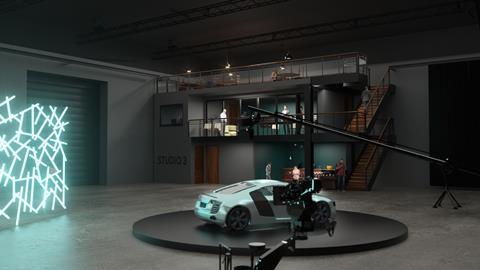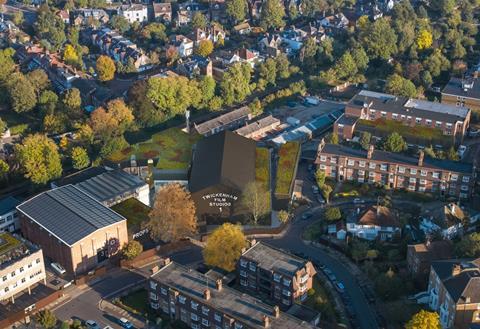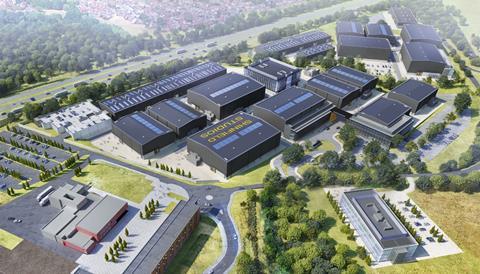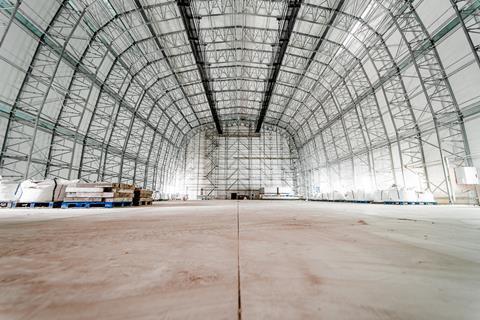The UK’s film and TV studios have struggled to meet booming demand for production space in recent years. This has triggered a wave of new developments, warehouse conversions and extensions to existing studios, but the current development pipeline still appears insufficient to satisfy future demand, Josephine Smit reports

The construction industry and most members of the acting profession have something in common right now: both want to make it in the movies.
But, while actors are looking for a starring part in the film, construction’s diverse players would be happy to win the best supporting role by delivering the new generation of film studio complexes.
There has been a flurry of announcements of studio schemes across the UK, with activity driven by soaring levels of global demand for space from production companies working in feature films and streamed high-end TV (HETV) dramas. Conversion of industrial buildings and temporary structures is also helping to meet the demand in the short term.

But, as this sector takes off, there have been questions over how many plans will really convert to projects. “There is such a level of public interest around studios that proposed sites get press coverage as though they are going to happen, at a very early stage,” points out Christopher Berry, director with property consultant Lambert Smith Hampton, which last year published the report Sites, Camera, Action! Take 2.
“This is often before they have either planning or funding, and sometimes before the proposed developers even own the site,” he adds.
“There is a sense of excitement that comes with a film studio,” echoes Mark Batchelor, director at planning consultant Boyer, which worked on the planned revamp and expansion of west London’s historic Twickenham Studios.
Big names in the sector
In its 2021 report, Reel Estate – Film and TV Studios as an Investment, property consultant JLL said there was 4.5 million ft2 of potential development activity in the sector, which – if realised – could double the UK’s studio footprint. Record demand for studio space has attracted the attention of institutional investors such as Blackstone, which has acquired a 91-acre site in Broxbourne, Hertfordshire, with Hudson Pacific Properties for a planned studio complex.
“Traditionally, film studios were owned by private individuals, but ownership is changing rapidly. There is now more US private equity in the sector, and we are seeing signs of interest from pension funds,” says Michael Davis, JLL’s film studio lead.
Such investors are looking to develop large-scale studios of up to 1 million ft2. “Their plans echo the template of the US in being huge, new state-of-the-art buildings with state-of-the-art rigging, lighting and acoustic treatment, workshop buildings, on-site amenities and so on. That is what the future of filming will look like in the UK,” says Davis.
The real challenge is to bring facilities to the market quickly enough to align with production programmes
Jason Lebidineuse, director of Scott Brownrigg
“The real challenge for project teams working in the film sector is the ability to bring facilities to the market quickly enough to align with production programmes,” says Jason Lebidineuse, director of architect Scott Brownrigg. Identifying the right site and bringing a proposal through the planning process may take time, but the end result still has to give the market what it wants.
“Film production is a highly adaptable and creative industry. We must ultimately mirror these qualities in the facilities we provide, at the same rate as – if not faster than – the industry moves forward,” he says.
The practice’s masterplan and design for Shinfield Studios, a 900,000ft2 media hub at Thames Valley Science Park in Berkshire, secured full planning permission in early January. Owner Blackhall Global Partners already has four sound stages ready for use there, and the whole 18-stage facility is due for completion by the end of 2024.
Flexibility and sustainability are central to the design, with the latter confirmed by targeting a BREEAM Excellent rating that is set to be achieved through a fabric-first approach and the use of technologies such as air-source heat pumps and photovoltaic arrays.

The arrival of new players with ESG high on their corporate agenda is helping to drive more sustainable solutions in the sector, says JLL’s Davis. He sees an opportunity for modular construction to help deliver more sustainable buildings, mentioning his own discussions with architects about using cross-laminated timber (CLT) or hybrid CLT and steel.
The sector is a natural fit for modular approaches, he says, given that “we know the optimum size and height of these buildings and the skill is generally in the internal fit-out”.
Technology has always been an essential component of studios and is rapidly evolving. “We are designing buildings so their spatial arrangements can flex as advancements in technology change the way in which the industry operates,” says Lebidineuse.
“Now we have the introduction of Ultra HD, which has a profound impact on the quality of finish our clients now require.”
Lebidineuse also mentions the recent expansion of digital CGI, such as special effects, augmented reality and gaming, in the UK. As a result of that, he says, “a number of larger players are seeking to relocate from central London bases to established catchments for digital creativity and, ideally, to co-locate alongside production studios in open, campus-style offices with contemporary design and amenities.”
Promoting best practice
“On the face of it, film stages are simply ‘big sheds’, but they’re actually technically complex spaces,” Alistair Weir, partner of architect PRP, explains. “In design terms the requirements of film stages are similar to those of an industrial process, with the ‘manufacturing output’ being digital content, and the working environment that they need for that is highly controlled. Filming involves a complex interaction between envelope, services and structure.”
The practice has been involved in film studio development for around a decade, making its debut with The Sharp Project, a warehouse regeneration delivered by Manchester city council. It has worked on a string of projects since, including Eastbrook Studios, the new 550,000ft2 complex under construction in Dagenham.
Eastbrook Studios was initially brought forward by the London borough of Barking and Dagenham via its Be First development vehicle, which secured planning consent to help attract an investment partner. US studio investor and operator Hackman Capital Partners, working with its affiliate The MBS Group, is now taking the project forward, having revised the design to reflect the sector’s focus on maximising flexibility and use.
It is difficult to predict how space will be used, so flexibility is needed to allow stages to be adapted and to allow support spaces to be used for a range of production activities
Alistair Weir, partner at PRP
“It is difficult to predict how space will be used, so flexibility is needed to allow stages to be adapted and to allow support spaces to be used for a range of production activities,” explains Weir. “The design now gives the ability for space to be adapted and is a much bigger facility, having grown by around 100,000ft2.”
Best practice in the development of bespoke studios, conversions and demountable premises for film and HETV production is being captured in new guidance produced by the British Film Commission (BFC) with the help of PRP. The BFC aims to help the sector deliver more studio space in the UK, with backing from the Department for Digital, Culture, Media and Sport. It is providing guidance through feasibility, supporting pre-planning design and planning stages of the development process, as well as through its research programme.
“Having worked in and around studios for some 27 years, I know there’s been a tendency to talk in code at times, says Jeremy Pelzer, senior stage-space strategy adviser with the BFC. “There is an appetite and ambition on our part to demystify the ways we reference some aspects of what we do.”
The guidance has to serve the three groups involved in the sector – investors/developers, operators and end users – which often have differing levels of understanding of what makes good studio space.

End users have been invited to give their feedback on what works and what does not from a production point of view, to inform the guide. “That’s because ultimately there are two key components of a stage: the control of light and of sound,” says Pelzer.
The intention behind this is not to dictate design, but to present the pros and cons of individual elements and approaches to aid decision-making.
The guide covers design and architecture, structural and acoustic considerations and M&E. “By capturing current best practice and anticipating emerging trends, this document will establish core design principles for the sector,” says PRP’s Weir.
Pelzer adds: “We hope it will be a living document. The work we’re undertaking is the initial phase, hopefully, of a body of work that we can share with relevant parties and update.”
It is difficult to apply some of the logic of environmental standards for more standard building typologies such as housing or offices to film studios
Alistair Weir, partner at PRP
Sustainability will also be among the best practice areas documented in the guide. “Areas like sustainability are becoming more and more relevant, and production companies are looking to studios to help them meet their sustainability objectives,” explains Weir.
There is currently little by way of sector-specific standards or guidance on sustainability, apart from the Albert toolkit, which covers everything from studio facilities to costumes.
“It is difficult to apply some of the logic of environmental standards for more standard building typologies such as housing or offices to film studios,” says Weir.
The BFC has two current research projects – one looking at ways of retrofitting existing studios to make them more sustainable, and another to measure the embodied carbon and projected operational energy use for new-stage development – that will help to develop understanding and potentially feed into the guidance.
“If we as a sector can better understand the spaces we are creating and working practices, we may be presented with opportunities to do things differently,” Pelzer says.
Rapid responses to demand
A number of names are bringing a fresh approach by developing studio space in existing buiIdings or temporary spaces. Among them is RD Studios, which is completing the specialist fit-out of a warehouse in Park Royal, west London.
The 45,000ft2 facility, which was the subject of a sustainable refurbishment by owner Segro, is RD Studios’ first large-scale studio scheme and part of its business strategy to create 250,000ft2 of independent studio space within five years.
Ryan Dean, founder of one of Europe’s largest commercial and corporate content creators, is behind RD Studios. He says the company’s ambition grew out of constraints on his own business expansion presented by the shortage of suitable sound studios.
“There are a lot of studios in England that are little more than farmers’ sheds, with no soundproofing, toilets or production facilities,” he says. By contrast, RD Studios’ building has five soundproofed stages, hair, make-up and wardrobe facilities, on-site kitchens, green rooms, post-production facilities and more.

The specialist conversion has been masterminded in-house. “Because of our long-term strategic objective, we have been the main contractor, and sourced our consultants and suppliers,” says Dean. That has meant securing specialised products such as the six million soundproof doors, made in Carlisle, although Dean says managing the fit-out has been fairly straightforward.
“Resource issues were the biggest concern, but we’re ahead of schedule, on budget and set to open from April,” he adds.
He sees analogies between building his content business of more than 100 film-makers and developing a studio network. “When I came into film production we shook it up by bringing the process in-house,” he says.
“In the construction industry there is an underlying lack of trust around project timelines and costings. We’ve been able to run this project very tightly.”
We’ve had to work really hard with teams to teach them what goes into a specialised facility like this
Ryan Dean, founder of RD Studios
One factor that has helped the firm to deliver, says Dean, is the way it has worked with the construction supply chain to achieve the right result. “We’ve had to work really hard with teams to teach them what goes into a specialised facility like this,” he explains.
Troubadour Theatres is also making its mark in the film industry in London, having progressed from operating its venues for theatres or ad hoc film production and events to converting Wembley Park Theatre to an interim film studio and building a film studio complex in Enfield during the pandemic.
“Our bespoke structures were always designed to accommodate the variety of needs required from the theatre, events and film industry,” explains Troubadour’s chief operating officer Rowley Gregg.

The company took a 16-year lease on a site at Meridian Waterin Enfield, where it has built phase one of its Troubadour Meridian Water complex, including three sound stages with a combined size of over 45,000ft2. By 2024, Troubadour aims to have completed phase two, adding a further 60,000ft2 of sound stages, alongside workshops, offices and other uses.
The stages meet an urgent market need, Gregg explains: “Due to the meanwhile nature of our studios, we can build our facilities in as little as 16 weeks, while a conventional complex may take three to five years to build, and importantly around 90% of the structures are reusable. So, at the end of its occupation in one location, we can transfer the entire structure to another site.”
The company already has its next project on the way, having late last year sealed a deal with Barnet council and developer Argent Related to create a temporary studio on a 150,000ft2 site in a former retail shed in Brent Cross. There is likely to be more to come, with the company targeting sites in areas going through regeneration, which stand to benefit from the positive impacts studios can bring.
Gregg says, “Not only do our venues bring mainstream productions or act as a cultural hub to an area but they also focus on building partnerships with local businesses and, most importantly, act as a catalyst for local employment while at the same time educating students [through] their skills academy programme.”
Will it last?
The current revolution in the UK’s studio sector might be regarded as overdue. “Until 20 years ago a lot of the stage space in the UK was the same as it had been for several decades,” says BFC’s Pelzer. But that picture is changing rapidly as the UK looks to take advantage of the global growth of streaming and HETV.
“While it is a global phenomenon, the UK is at the forefront of the growth,” Pelzer continues. “We now have a development pipeline of new space that meets the sector’s growth trajectory for the next four to five years, although we’ll probably still need to consider conversions in the meantime. We need to ensure we can meet the ambitions of the sector and support the opportunity for investment.”
Looking further ahead, continuation of high levels of studio development activity may ultimately depend on the public’s appetite for subscription TV services, but JLL’s Davis believes activity could be boosted by streaming companies’ own appetite for growth.
“Companies like Netflix are already starting to think about how they diversify their business model,” he points out. “I can see that studios may become boxes – used for e-sports and video game creation – where content is consolidated.”




























No comments yet